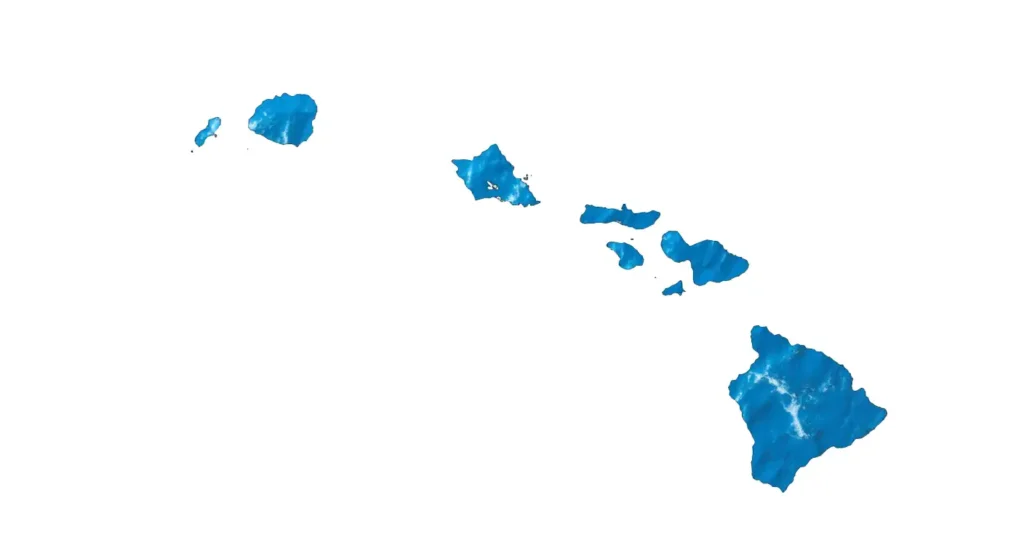Free Hawaii Payroll Tax Calculator

Hawaii Payroll Tax Calculator (Step-by-Step)
Understanding your paycheck is crucial, and our Delaware Payroll Tax Calculator simplifies the process. Follow these easy steps to get an accurate estimate of your net pay:
Step 1: Enter Your Location and Filing Status
Country: Confirm “United States” is selected. (This is pre-filled.)
Province/State: Choose “Hawaii” from the dropdown menu. (This is pre-filled.)
Federal Filing Status: Select your federal tax filing status (e.g., Single, Married Filing Jointly, etc.). This determines your federal withholding.
Federal Allowances: Input the number of federal allowances you’re claiming. This affects how much federal income tax is withheld from your paycheck. (Refer to your W-4 form.)
State Filing Status: Choose your Hawaii state filing status. This often mirrors your federal status but confirm it with your most recent state tax information.
State Withholding Allowances: Enter the number of Hawaii state withholding allowances you are claiming. (Use Hawaii Form HW-4 as a reference.)
Step 2: Input Your Pay Information
Annual Pay Periods: Select how frequently you’re paid — Bi-Weekly (26), Weekly (52), Monthly (12), etc.
Gross Wage / Pay Period: Enter your total earnings before deductions for the selected pay period.
Pay Date: Choose the pay date using the calendar. (This is for your reference and does not affect the tax calculation.)
Step 3: Calculate Your Taxes
Review the tax breakdown provided by the calculator.
Adjust any fields if needed and click “Calculate” again to refresh your results.
Click “New Calculation” to begin with new inputs.
Important Notes:
This calculator offers a tax estimate based on Hawaii’s current tax rates and regulations.
Your actual tax withholding may vary depending on:
Pre-tax deductions (e.g., retirement plans, insurance)
Additional income
Local surcharges or changes in legislation
Make sure your W-4 and Hawaii Form HW-4 are up to date to maintain accurate tax withholding.
Found our Free Hawaii Payroll Tax Calculator useful? Bookmark and share it.

Hawaii Payroll Tax 2025
Hawaii has a multi-layered payroll tax system that encompasses both federal and state taxes. As an employer, you are responsible for withholding federal taxes (like IRS income tax and FICA) and Hawaii state taxes from employee paychecks, as well as paying certain employer taxes. The Aloha State is known for having progressive state income tax rates – the higher an employee’s wages, the more state tax is owed. In fact, Hawaii’s state income tax is one of the most complex, with 12 tax brackets ranging from 1.4% on low incomes up to 11% on the highest incomes. (These brackets were widened in 2025 as part of a tax relief law, increasing the income thresholds so many workers pay lower rates.) On the other hand, Hawaii makes up for its high income taxes by not charging general sales tax on goods (Hawaii uses a General Excise Tax on businesses instead).
In addition to income taxes, Hawaii employers must handle state unemployment insurance (SUI) contributions and ensure compliance with unique state mandates like Temporary Disability Insurance. All these state obligations come on top of federal payroll taxes like Social Security, Medicare, and FUTA. Whether you run a mom-and-pop shop or a growing company, mastering Hawaii payroll taxes – knowing the rates, forms, and deadlines – is critical to avoid penalties. In the next sections, we’ll break down the process, step by step.
Hawaii State Income Tax Withholding
Hawaii applies a progressive state income tax system with up to 12 brackets in 2025. The lowest rate is 1.4% on the first $9,600 of taxable income for single filers, while the highest rate reaches 11% for income exceeding $325,000. Most employees fall somewhere in between.
Significant changes from Act 46 (2024) widened tax brackets starting in 2025, resulting in more income being taxed at lower rates. For many employees, this means slightly lower state withholding amounts compared to previous years, assuming no major changes in personal circumstances.
Hawaii does not impose local income taxes—only state income tax applies. Employees must complete Form HW-4 at the time of hire, allowing them to claim withholding allowances based on personal exemptions and deductions. These allowances reduce the amount of wages subject to tax, similar to the old federal system.
Employers use the information on HW-4, along with Hawaii’s approved methods (either a percentage of wages or tax tables in Booklet A), to calculate withholding. Importantly, employees cannot claim exempt status—state law requires a nominal withholding amount even for low-income earners. Employers should use the latest version of the 2025 tables to ensure accuracy and avoid under- or over-withholding.
Hawaii Wage Withholding Thresholds
There’s no specific wage floor in Hawaii below which income becomes exempt from withholding. However, standard deductions and personal exemptions effectively shield a portion of low-income wages from taxation. These deductions are increasing yearly through 2031, as part of the same Act 46 reforms.
For example, a married employee may owe no tax on the first few thousand dollars of annual income after allowances are factored in. Employers don’t calculate these deductions manually—they’re incorporated into the worksheets on Form HW-4 and the withholding tables themselves.
It’s essential to update your payroll system annually. Using outdated tables can result in incorrect withholding, leading to either employee overpayment or tax due at year-end.
Hawaii State Unemployment Insurance (SUI)
Hawaii employers are required to pay state unemployment insurance (SUI) taxes. Employees do not contribute to this tax—it is employer-funded only. In 2025, the taxable wage base is $62,000 per employee. Wages beyond that amount are not subject to further SUI taxes.
SUI tax rates in Hawaii are experience-rated, ranging from 0.0% to 5.6%. New employers in 2025 will pay a standard rate of 2.4%, which equals up to $1,488 per employee per year.
In addition to SUI, Hawaii also requires a tiny Employment & Training (E&T) Assessment of 0.01% on the same wage base, amounting to a maximum of $6.20 per employee per year. This is typically included in your annual SUI rate notice from the Department of Labor & Industrial Relations.
Temporary Disability Insurance (TDI)
Hawaii mandates Temporary Disability Insurance (TDI) coverage for non-work-related illnesses or injuries. This is not a tax, but it does affect payroll processes. Employers may withhold up to 0.5% of an employee’s weekly wages, capped at $7.21 per week in 2025, to help pay for the premium.
For example:
If an employee earns $800/week, the employer may deduct $4.
If they earn $2,000/week, the deduction is limited to $7.21 (despite 0.5% equaling $10).
Employers cover the remaining premium balance. Many opt to pay the full cost as a benefit. Any TDI deduction must be treated as a post-tax payroll deduction. Employers are required to either buy a TDI policy or be approved for self-insurance to comply with the law.
Federal vs. State Tax Nexus
Hawaii does not have reciprocal income tax agreements with other states. Therefore, if an employee earns income in Hawaii, the employer must withhold Hawaii income tax regardless of the employee’s state of residency.
Typically, the employee will be able to claim a credit on their home state return to avoid double taxation. Similarly, Hawaii residents working remotely in other states may still owe Hawaii income tax, with a credit allowed for tax paid elsewhere.
Employers should be aware of this if they have remote workers or employees who split work locations across state lines. When in doubt, consult a tax professional to avoid compliance issues.
Other Hawaii Payroll Considerations
Paid Leave Taxes: Hawaii currently does not impose any payroll taxes for paid family leave or state-mandated sick leave programs. Employers may offer such benefits voluntarily, but no tax is collected for them.
Minimum Wage: Hawaii’s state minimum wage is $14.00/hour in 2025, rising to $16.00/hour in 2026. This exceeds the federal minimum and must be observed for all hourly workers.
Payroll Account Registration: Employers must register with the Hawaii Department of Taxation for withholding and the Department of Labor & Industrial Relations (DLIR) for unemployment insurance. Online registration is available and covers both agencies. Employers must have account numbers to remit tax payments and file returns correctly.


Federal Payroll Taxes (Apply in All States)
These taxes are collected by the IRS and federal agencies. They apply nationwide, including in Hawaii:
Federal Income Tax (FIT)
Federal income tax is withheld from an employee’s paycheck based on IRS tax tables and the details provided on their Form W-4. The tax is calculated using marginal rates, which range from 10% to 37% depending on income and filing status.
There is no income cap—all wages are subject to this tax. Employers are responsible for depositing the withheld amounts to the IRS (typically using Form 941). Employees may also request extra withholding or adjustments based on factors like multiple jobs or dependents.
Social Security Tax
This tax is part of FICA (Federal Insurance Contributions Act). Social Security tax is:
6.2% withheld from the employee
6.2% paid by the employer
Applied only to the first $176,100 of annual wages in 2025.
Wages beyond that are not subject to Social Security tax. For example, if an employee earns $176,100 in 2025, both employer and employee will each pay $10,918.20 toward Social Security.
Medicare Tax
The other half of FICA, Medicare tax is:
1.45% withheld from the employee
1.45% paid by the employer
No wage cap—all wages are taxed.
Additionally, if an employee earns over $200,000 in a calendar year, an extra 0.9% Additional Medicare Tax must be withheld by the employer (bringing the total to 2.35% on income above that threshold). There is no employer match for this extra 0.9%.
Federal Unemployment Tax (FUTA)
FUTA is an employer-paid tax:
6.0% on the first $7,000 of each employee’s wages.
Most employers qualify for a 5.4% credit if they pay state unemployment taxes on time.
With the credit, the effective rate is 0.6%, or $42 per employee per year.
FUTA is reported annually on Form 940. Even though it’s a small expense, it must be included in payroll planning.
Hawaii State Payroll Taxes
These are taxes and contributions required by the State of Hawaii:
Hawaii State Income Tax
Hawaii’s state income tax is withheld from employees’ pay and remitted to the Department of Taxation. For 2025:
Rates range from 1.4% to 11%.
The exact withholding depends on income, marital status, and allowances claimed on Form HW-4.
No income cap exists—higher wages are taxed at higher marginal rates.
Employers calculate withholding using Hawaii’s tax tables or percentage methods and report via Form HW-14 (periodic returns) and Form HW-3 (annual reconciliation).
Hawaii State Unemployment Insurance (SUI)
SUI is:
Employer-paid only (not withheld from employee wages).
Applies to the first $62,000 of each employee’s wages in 2025.
Rates range from 2.4% to 5.6%, depending on employer experience.
New employers pay a default rate of 2.4%.
Payments are submitted quarterly to Hawaii’s Department of Labor. These contributions also qualify employers for the FUTA credit on federal taxes.
Temporary Disability Insurance (TDI) Contributions
TDI is mandatory in Hawaii. Employers must provide coverage for non-work-related illness or injury. While not a tax, it may involve payroll deductions:
Employers may withhold up to 0.5% of an employee’s weekly wages, capped at $7.21 per week.
Any remainder of the premium is paid by the employer.
Deductions are post-tax and should be clearly labeled (e.g., “TDI Insurance”) on employee pay stubs.
Employers either purchase TDI policies or apply for state-approved self-insurance.
No Local or Additional State Payroll Taxes
Hawaii:
Does not impose any local payroll taxes (e.g., county income tax).
Does not have separate state disability insurance (SDI) taxes or paid family leave payroll deductions.
Has a General Excise Tax (GET) on business revenue, but that is separate from payroll processing.
For payroll purposes, Hawaii’s primary state tax responsibilities are:
State income tax withholding
State unemployment insurance
Optional employee TDI deductions

Other Payroll Tax Calculators
Loading other available calculators...
Disclaimer: The content provided on this webpage is for informational purposes only and is not intended to be a substitute for professional advice. While we strive to ensure the accuracy and timeliness of the information presented here, the details may change over time or vary in different jurisdictions. Therefore, we do not guarantee the completeness, reliability, or absolute accuracy of this information. The information on this page should not be used as a basis for making legal, financial, or any other key decisions. We strongly advise consulting with a qualified professional or expert in the relevant field for specific advice, guidance, or services. By using this webpage, you acknowledge that the information is offered “as is” and that we are not liable for any errors, omissions, or inaccuracies in the content, nor for any actions taken based on the information provided. We shall not be held liable for any direct, indirect, incidental, consequential, or punitive damages arising out of your access to, use of, or reliance on any content on this page.
Trusted By
Trusted by 3.2M+ Employees: 21 Years of Service Across Startups to Fortune 500 Enterprises
Join our ever-growing community of satisfied customers today and experience the unparalleled benefits of TimeTrex.










Strength In Numbers
Join The Companies Already Benefiting From TimeTrex
Time To Clock-In
Start your 30-day free trial!
Experience the Ultimate Workforce Solution and Revolutionize Your Business Today
- Eliminate Errors
- Simple & Easy To Use
- Real-time Reporting

Saving businesses time and money through better workforce management since 2003.
Copyright © 2025 TimeTrex. All Rights Reserved.
